There are around 11,700 species of reptiles in the world today and some, but not all of them, have keeled scales. Keeled scales refer to reptile scales that have a distinctive ridge down the center, giving them a rough texture rather than being entirely smooth. Sometimes the ridge is only down the center of the scale, while other times it extends to the tip. Quite often, scales are strongly keeled down the dorsal scales of the reptile and gradually become less keeled down the sides of the body, ending with smooth scales on the belly. However, some snakes with keeled scales have them on their belly too.
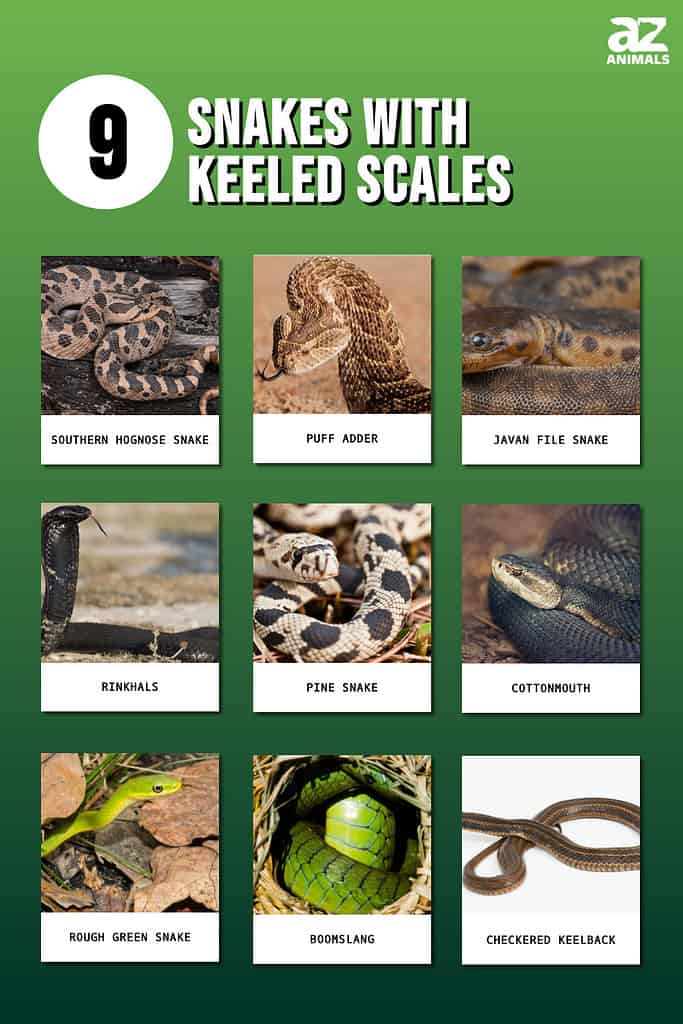
It’s not known exactly why some snakes have keeled scales, but theories suggest that they might help them with camouflage. This is because keeled scales aren’t as shiny as smooth scales which might mean that they can hide better in sunlight. Not only that, but keeled scales on the bellies can help with movement or climbing. Additionally, almost all vipers have keeled scales and some have minute serrations on the keels which they can use as a warning display. They do this by coiling themselves and rubbing the scales together to create a buzzing or sizzling sound. So, although not every snake has keeled scales, quite a lot do. So join us as we discover some snakes with keeled scales!
Southern Hognose Snake
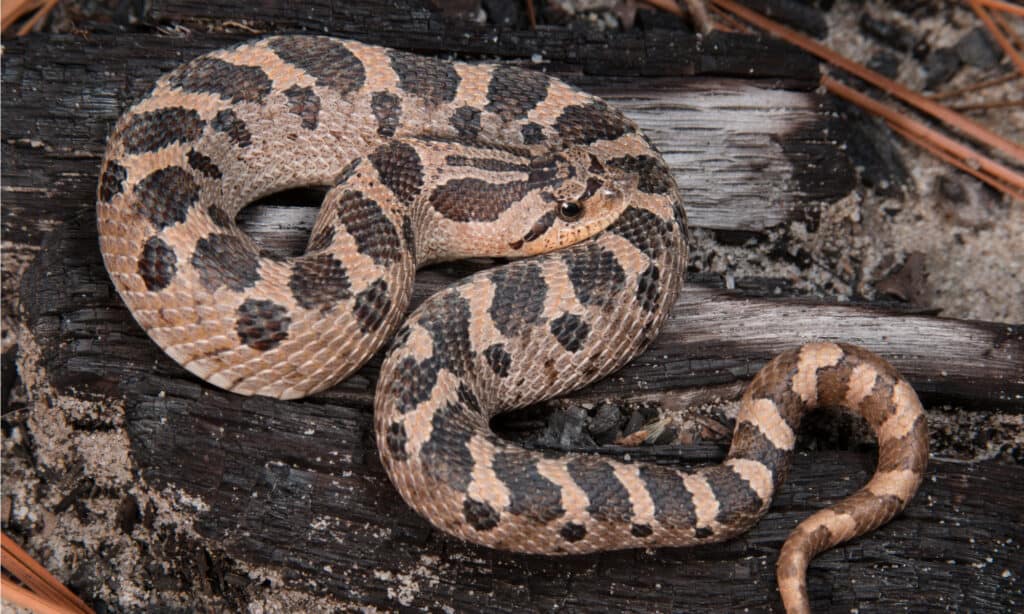
The southern hognose snake,
Heterodon simus, has keeled scales in the middle of its body whose colors can range from red to yellow to light brown with dark blotches.
©Nathan A Shepard/Shutterstock.com
A vulnerable snake with keeled scales is the southern hognose snake (Heterodon simus) which is endemic to the southeastern United States. They are 14 to 24 inches long and have an unusual appearance with a wide neck and a noticeably upturned snout. Southern hognose snakes are gray, brown, or red with large dark blotches on their bodies. They have 25 rows of keeled dorsal at their midsection. Southern hognose snakes prefer to live in dry, sandy areas such as dry floodplains, fields, and sandhills. Although they produce a mild venom that they use to subdue their prey with they are not dangerous and rarely bite. Instead, they prey on frogs, toads, and lizards.
Puff Adder

The puff adder has a distinct triangle-shaped head and strongly keeled dorsal scales
©iStock.com/EcoPic
One of the most venomous snakes in Africa is the puff adder (Bitis arietans), which is responsible for more fatal bites than any other African snake. Puff adders average 3 feet long with males being larger than females. They are usually a brownish color with brown, grey, or black chevron markings and have a triangular-shaped head that is wider than their neck. Puff adders have 29 to 41 rows of strongly keeled dorsal scales. However, the keel is much weaker on the outermost rows. Puff adders usually live in grasslands and savannahs and feed on a range of birds, lizards, frogs, and mammals. When disturbed they hiss violently while coiling into a protective posture. However, they strike fast and with deadly accuracy.
Javan File Snake
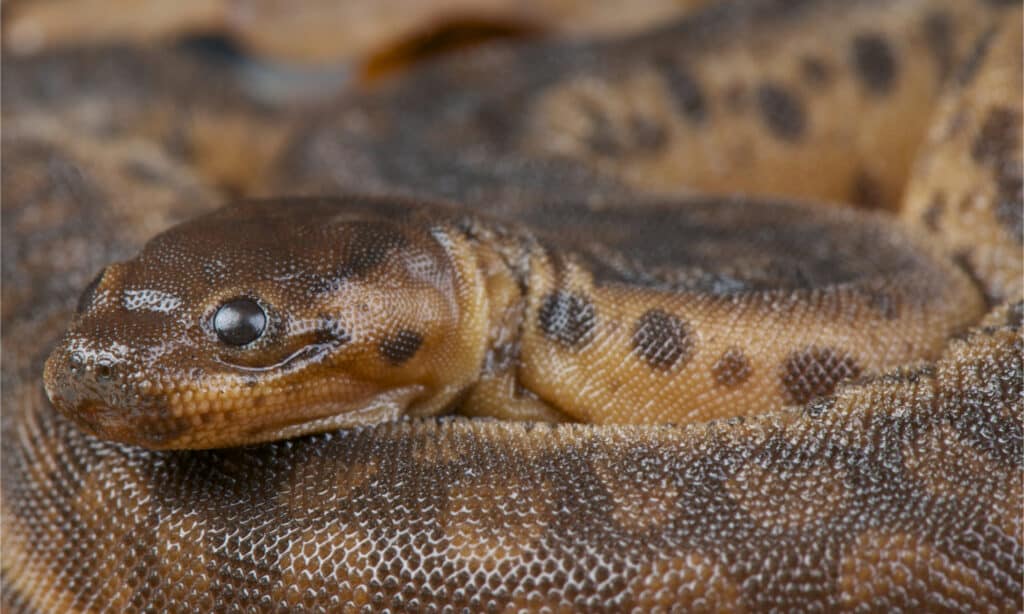
Javan file snakes have baggy skin and keeled scales which make them feel like sandpaper
©reptiles4all/Shutterstock.com
Also known as the elephant trunk snake, Javan file snakes (Acrochordus javanicus) can grow to lengths of up to 8 feet, with females being longer than males. They are dark brown with cream sides and bellies. However, the most unusual thing about these snakes is their skin which is extremely baggy and almost seems to be too big for their bodies. Their skin itself feels extremely coarse like sandpaper due to their strongly keeled scales which are like large hooks. Javan file snakes are native to Sumatra and are aquatic snakes. They prefer to live in slow-moving water – such as rivers, lakes, streams, and swamps. They spend the majority of their lives in the water and very rarely come onto land. Javan file snakes feed mainly on fish and amphibians.
Rinkhals
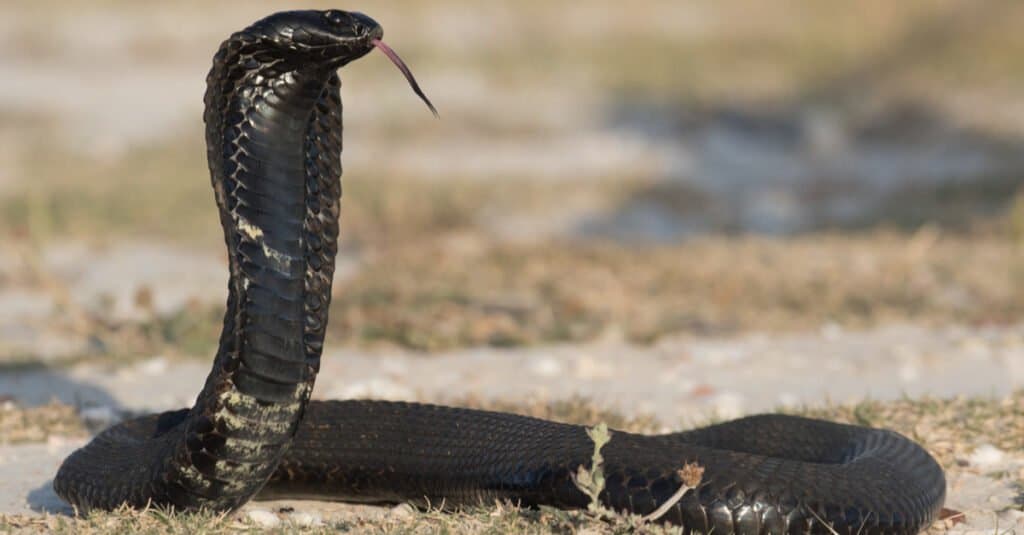
Despite their appearance, rinkhals are not true cobras
©Andre Coetzer/Shutterstock.com
Another venomous snake from Africa is rinkhals (Hemachatus haemachatus). Rinkhals are 35 to 43 inches long and have mostly black bodies with one or two white crossband markings on their throat area. Rinkhals are often mistaken for cobras because of the way that they raise themselves up off the ground and display their hood when they are threatened. However, they are not classed as true cobras due to the distinctive differences between their scales. This is because, unlike cobras, rinkhals have keeled dorsal scales which display as a prominent ridge. Rinkhals prey mainly on toads, small mammals, and other reptiles. As a spitting snake, rinkhals can spray their venom as far as 6 feet. When faced with a human they tend to aim their venom at the eyes which can cause intense pain.
Pine Snake
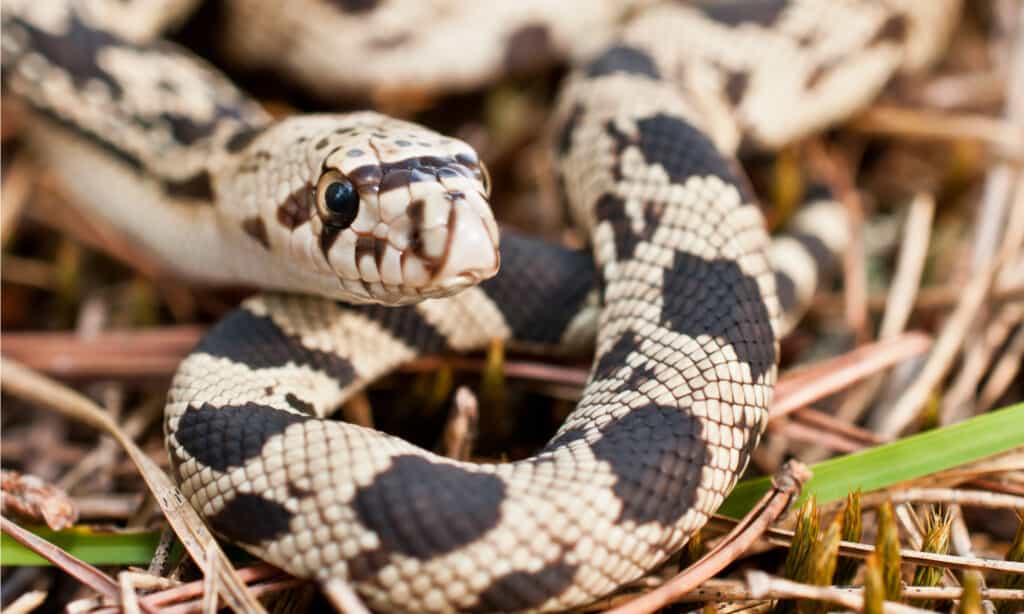
Pine snakes have 27 to 37 rows of keeled dorsal scales
©Jay Ondreicka/Shutterstock.com
A non-venomous snake with keeled scales is the pine snake (Pituophis melanoleucus), which is endemic to the southeastern region of the United States. Pine snakes are 48 to 90 inches long and are a light brown color with brown or reddish-brown blotches. They have small, pointed heads and 27 to 37 rows of strongly keeled dorsal scales. There are three recognized subspecies of pine snakes and they live in flatwoods, prairies, and deserts at elevations up to 9,000 feet. They mainly prey on rodents and regularly enter their burrows in search of food. Their main predators are red foxes and skunks.
Cottonmouth

Although cottonmouths have keeled scales, the keels are weaker on the lowermost rows
©iStock.com/Saddako
Also known as water moccasins, venomous cottonmouths (Agkistrodon piscivorus) are 30 to 48 inches long. They are black or brown with a mixture of light and dark brown crossband markings. Cottonmouths have 23 to 27 rows of dorsal scales, all of which are keeled. However, the keels are much weaker on the lowermost rows. Cottonmouths are widespread across eastern US where they live in and around virtually every wetland habitat. They are not limited to only freshwater as they can be found in brackish water and near offshore islands. Cottonmouths are opportunistic feeders and eat anything they can catch – such as fish, lizards, birds, frogs, and other snakes (including fellow cottonmouths). Although they usually only strike as a last resort, cottonmouths are extremely venomous. Their venom contains toxins that destroys tissue and can lead to serious scarring and even amputation.
Rough Green Snake

The skin of a rough green snake makes it easy for it to climb trees.
©iStock.com/BobMcLeanLLC
One of the most stunning snakes native to North America is the rough green snake (Opheodrys aestivus). Rough green snakes are usually 14 to 33 inches long and have slender bodies and long, thin tails. They are bright green on their dorsal side with cream to yellow bellies. As their name suggests, they have a rough texture which is caused by their strongly dorsal-keeled scales. These are arranged in 17 rows at their mid-body section. Rough green snakes live in meadows and woodlands, although they are never far from water and are good swimmers. They are also highly arboreal snakes and spend much of their time in trees where their keeled scales help them to climb with ease. Rough green snakes are not venomous or aggressive and when threatened they usually just freeze. They mainly eat insects, spiders, and small frogs.
Boomslang
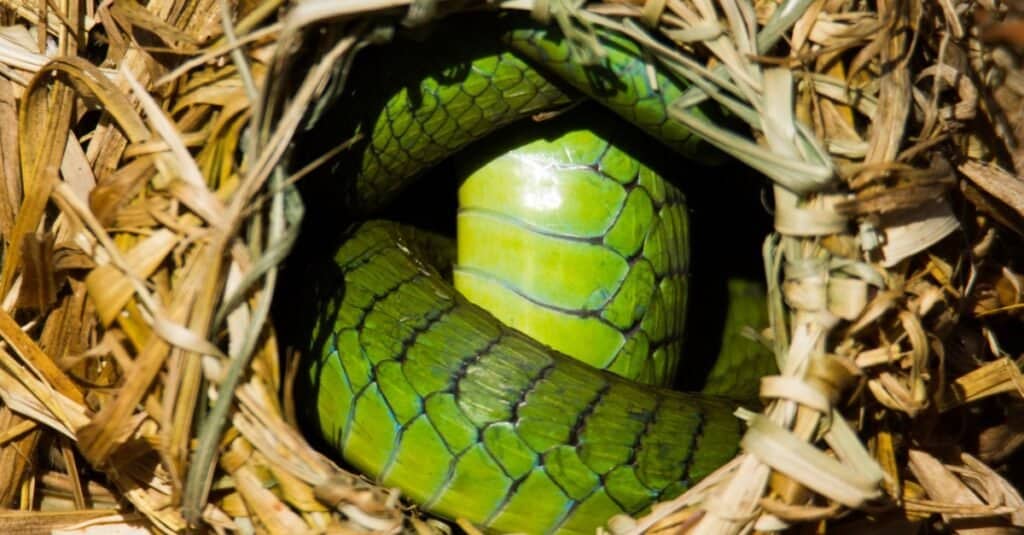
Male boomslangs are bright green and have a black or blue outline.
©iStock.com/Kiko Janneman
One of the most venomous snakes in the Colubridae family is the boomslang (Dispholidus typus), which is endemic to sub-Saharan Africa. Boomslangs are 3.3 to 5.2 feet long and have large eyes and a distinctive egg-shaped head. Females are usually brown while males are green with blue or black edges on their scales. They have 19 to 21 rows of strongly keeled dorsal scales which are noticeably narrow. Boomslangs have small teeth but large fangs at the rear of their jaw which they use to inject their highly potent venom with. Although their venom is slow-acting it interferes with the coagulation process of the blood which subsequently causes hemorrhaging and extreme bleeding. Boomslangs are highly arboreal and mainly live in forest regions where they prey on chameleons, lizards, birds, and small mammals.
Checkered Keelback
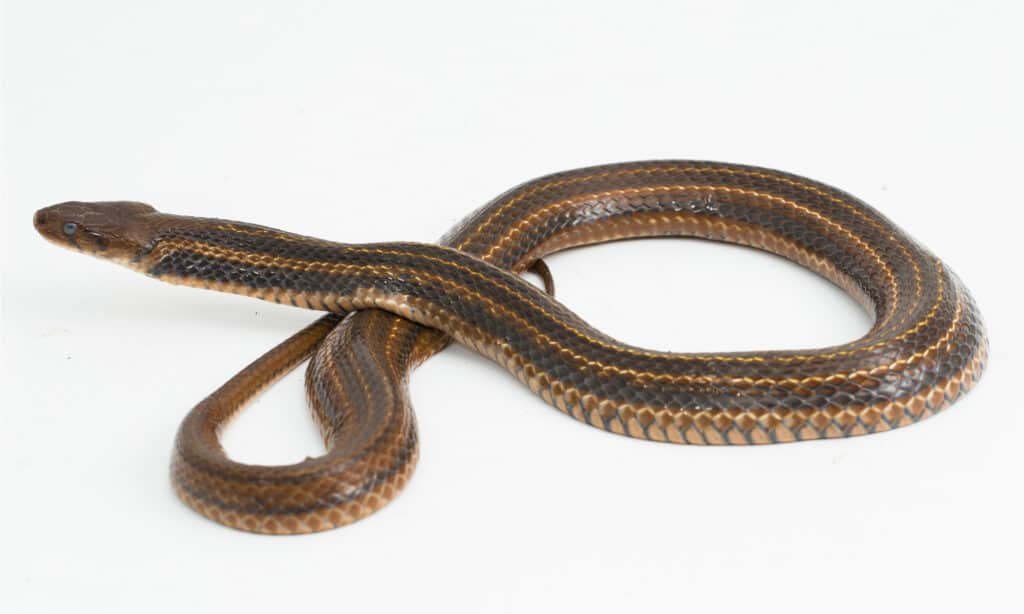
Checkered Keelbacks have strongly keeled dorsal scales
©dwi putra stock/Shutterstock.com
Also known as the Asiatic water snake, checkered keelbacks (Fowlea piscator) are non-venomous snakes that are native to Asia. They reach a maximum length of 5.7 feet and have a varied appearance which can consist of dark spots or crossbands on a paler background. However, almost all of them have two noticeable black markings – one below and one behind the eye. As their name suggests, they have strongly keeled scales. Checkered keelbacks have 19 rows of dorsal scales which are strongly keeled in the center but smooth on the outer rows. They typically live near lakes and rivers and prey mainly on frogs and small fish. When threatened they tend to try to mimic a cobra by raising and extending their neck.
Summary of 9 Snakes With Keeled Scales
| Number | Snake |
|---|---|
| 1 | Southern Hognose Snake |
| 2 | Puff Adder |
| 3 | Javan File Snake |
| 4 | Rinkhals |
| 5 | Pine Snake |
| 6 | Cottonmouth |
| 7 | Rough Green Snake |
| 8 | Boomslang |
| 9 | Checkered Keelback |
The photo featured at the top of this post is © LifeisticAC/Shutterstock.com
Discover the "Monster" Snake 5X Bigger than an Anaconda
Every day A-Z Animals sends out some of the most incredible facts in the world from our free newsletter. Want to discover the 10 most beautiful snakes in the world, a "snake island" where you're never more than 3 feet from danger, or a "monster" snake 5X larger than an anaconda? Then sign up right now and you'll start receiving our daily newsletter absolutely free.
Thank you for reading! Have some feedback for us? Contact the AZ Animals editorial team.







